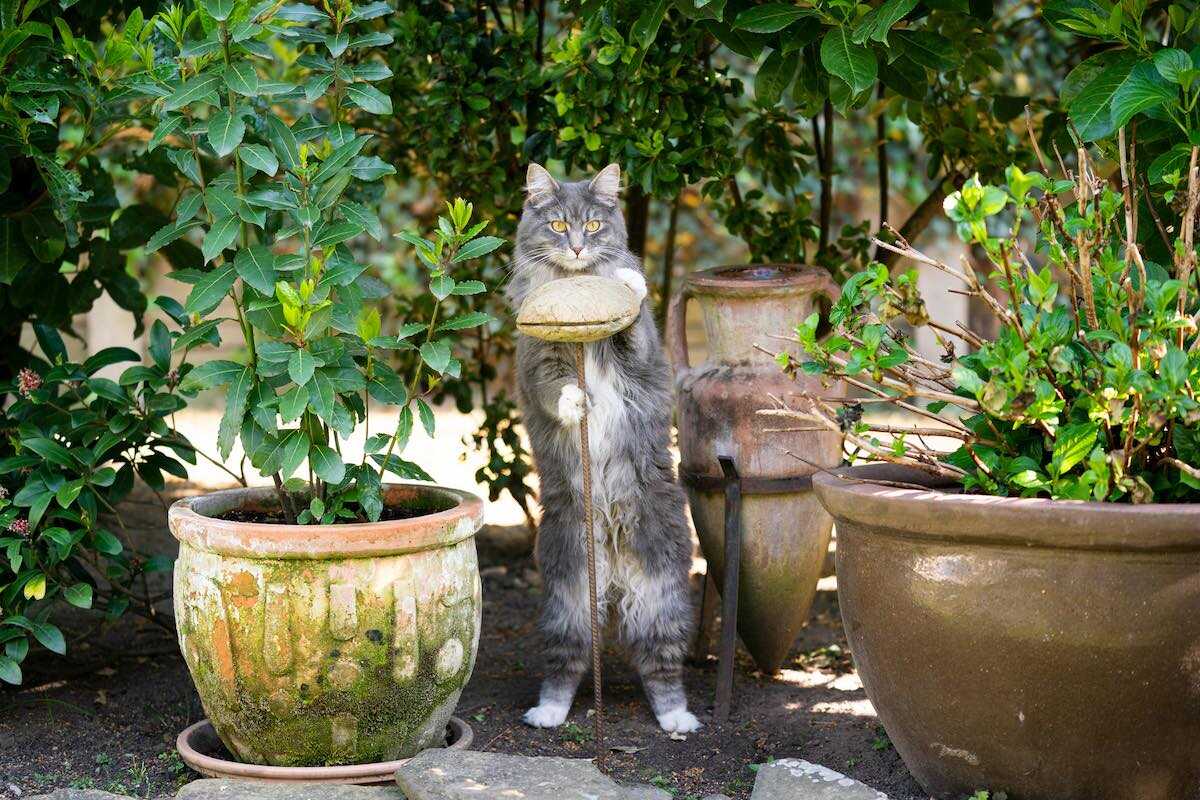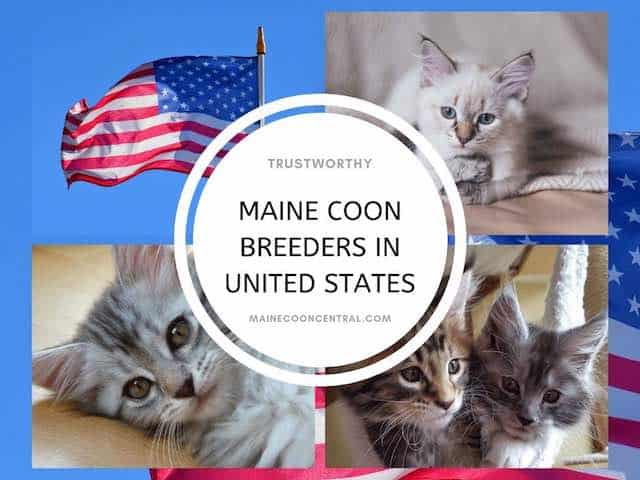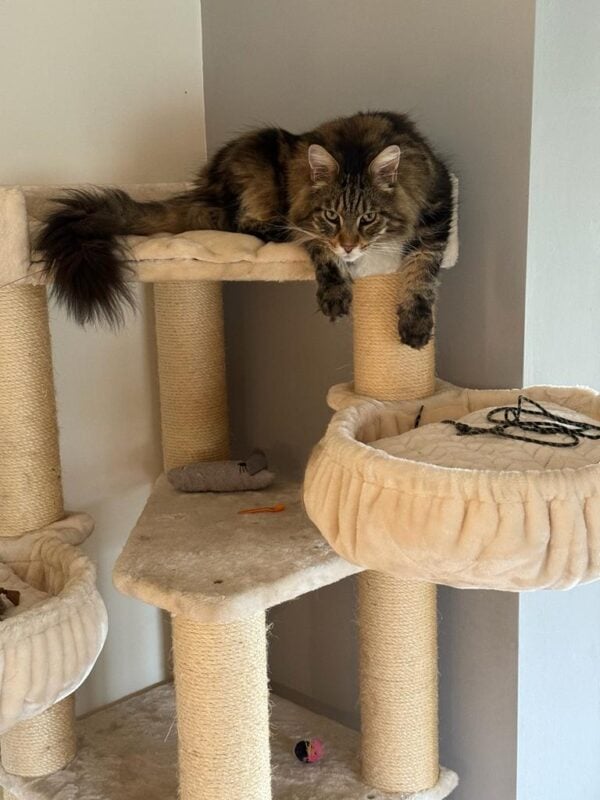European Maine Coon vs American Maine Coon

The Maine Coon is one of the largest and most popular cat breeds in the world, admired for its friendly nature, intelligence, and striking appearance. However, did you know there are two distinct types: the European Maine Coon vs American?
While both share the breed’s characteristic size and affectionate personality, they differ slightly in their physical appearance. Will their differing visuals affect which type of Maine Coon cat you buy?
The European Maine Coon tends to have a wild, rugged look with sharper facial features and larger lynx-like ear tufts, whereas the American Maine Coon has a more balanced, refined appearance with softer facial lines.
Scroll down if you want to learn how to tell the difference between the European Maine Coon vs American Maine Coon.
History Of The Breed
I was curious to learn how the two different types of Maine Coons (European and American Maine Coon cats) came to be, so I decided to investigate their origins!
It turns out the Maine Coon breed originated in the northeastern United States, particularly in Maine, where they were prized for their hunting abilities and their ability to thrive in harsh winters.
You can learn more about the Maine Coon Cats Origins in this guide. But, be warned … only read this article if you want to learn EVERYTHING there is to know about the largest domesticated cat breed in the WORLD!!
Ok, let’s get back to the matter at hand ….. The Maine Coon’s thick, semi-water-resistant coats and large, tufted paws kept them warm during the frigid cold winters and helped them walk on snow.
These large cats are superb hunters which made them a favorite among farmers and sailors alike.
By the 19th century, these cats had gained popularity for their size, intelligence, and friendly nature, and even appeared at some of the earliest cat shows in America.
While no one knows exactly how the breed came to be, many believe they descended from long-haired cats brought by seafarers or early settlers to the U.S.
New to the breed? Check out these 50 Fun Maine Coon Cat Facts.
Why Do They Look Different?
As I dug deeper, I discovered that as Maine Coons spread around the world, breeders in different regions developed individual ideas of what the breed should look like.
According to Catster, European breeders preferred more “wild” Maine Coon aesthetics and deliberately selected cats with features that gave the European Maine Coons a rugged, almost feral appearance:
- Sharper, more angular faces
- Longer muzzles
- Larger ears with dramatic lynx-like tips
- Thicker coats
Meanwhile, breeders in the U.S. stayed closer to the original look, focusing on Maine Coons with a more balanced and refined appearance, a squared muzzle, softer facial features, and a silkier coat.
This theory is supported by Untamed who states:
“European Maine Coons have larger ears with prominent tufts (similar to lynx), longer, bushier tails, and higher cheekbones. They also have a more majestic look, while American Maine Coons have softer, milder features that better resemble average house cats”.
These different breeding standards eventually resulted in the distinct European and American Maine Coon types we see today.
Physical Differences
There are a variety of physical differences between the European Maine Coon and American Maine Coon. Can you tell the difference?
While both Maine Coon “types” share the breed’s large size and distinctive look, there are subtle variations in the cat’s head shape, ears, coat, and build, as a result of regional breeding standards.
Here’s a summary of the key differences:
| Feature | American Maine Coon | European Maine Coon |
|---|---|---|
| Head Shape & Features | Broader, square-shaped muzzle, softer facial structure | Longer, more pronounced muzzle with a sharper, angular face |
| Ears and Lynx Tips | Slightly smaller ears, moderate lynx tips | Larger ears with more dramatic lynx tips and tufts |
| Coat & Fur | Softer, silkier, more balanced length | Thicker, rougher coat suited for colder climates |
| Size & Build | Slightly more refined, balanced build | A thicker, rougher coat suited for colder climates |
1. Head Shape And Facial Features
The American Maine Coon has a broader, more square-shaped muzzle, with a more balanced and softer facial structure. This gives them a gentler look, with less emphasis on wild or feral traits.
In contrast, the European Maine Coon has a more pronounced, longer muzzle, with sharper and more angular facial features. This creates a “feral” or “wild” appearance, a hallmark of the European breeding standard.


2. Ears And Lynx Tips
The ears of the American Maine Coon tend to be slightly smaller, with moderate lynx tips that are present but not as dramatic.
European Maine Coons often have larger, more prominent ears, with striking lynx tips and tufts, further enhancing their wilder aesthetic.
3. Coat And Fur
The American Maine Coon typically has a softer, silkier coat with a more balanced length. The fur tends to be less dense, giving them a slightly more polished appearance.
By comparison, European Maine Coons are known for their thicker, rougher coats, which are better suited for colder climates. Their fur is often denser, giving them a more rugged look.
If I’m honest I never realized this, so it now makes sense why my US readers always tell me their Maine Coon has silky fur! I live with two European Maine Coons, not American Maine Coons!

4. Size And Build
While both types of Maine Coon are considered larger than a normal cat, it’s the American Maine Coon that has a slightly more refined and balanced build. While still muscular, they tend to have a more streamlined appearance.
European Maine Coons on the other hand are typically more robust and muscular, contributing to their overall wild and rugged appearance.
Care Requirements
When I started learning about the care needs of both European and American Maine Coons, I realized that while they share many similarities, there are a few key differences to keep in mind.
Grooming Needs
Both the European and American Maine Coons have long, beautiful coats that require regular grooming to prevent matting and keep their fur in top condition.
However, because my European Maine Coons have a thicker and rougher coat, I need to brush them more frequently – ideally 2-3 times a week and more during the shedding season.
On the other hand, the American Maine Coon has a softer, silkier coat that doesn’t tend to tangle as easily, so a thorough brushing once or twice a week can usually keep things under control.
Whichever Maine Coon type you have, it’s important to brush your cats with these style brushes regularly since it helps reduce the instances of feline hairballs.
Health Considerations
You’ll be pleased to learn that neither the European nor American Maine Coons are more prone to certain health issues than the other. I imagine that would have freaked people out if they’d realized they’d invested in a more medically challenged cat.
This breed isn’t without its own genetically predisposed health issues though. Instead, they are prone to various health problems, including:
Hip Dysplasia
Hip dysplasia in cats is a genetic condition in which the hip joint doesn’t develop properly, leading to instability and abnormal wear between the femoral head (ball) and the acetabulum (socket).
This can result in arthritis and pain over time, though it is less common in cats than in dogs. Discover the most important Maine Coon Hip Dysplasia Facts.
Hypertrophic Cardiomyopathy (HCM)
Hypertrophic cardiomyopathy (HCM) in cats is a common heart disease characterized by the thickening (hypertrophy) of the heart muscle, particularly the left ventricle.
This thickening reduces the heart’s ability to pump blood efficiently, potentially leading to heart failure, arrhythmias, or sudden death.
Read my guide: Maine Coon Hypertrophic Cardiomyopathy.
Diet and Exercise
All Maine Coon cats (irrelevant of their ‘type’) need a high-quality diet that supports their size and activity level. In particular, their diets should be packed full of protein and be low in carbohydrates.
I recommend you read this Maine Coon Diet Guide to ensure you’re feeding your feline friend the best food possible.
All Maine Coons need regular exercise to stay fit and healthy. This large cat breed is playful and energetic, so keeping them engaged is essential.
I aim to give my two Maine Coon cats 20-30 minutes of exercise a day to help stimulate their minds and burn off excess calories. Mika is a little overweight at the moment and needs more playtime than Bali!

I also make sure my beautiful cats have plenty of interactive toys to play with whilst I am away from home, as this helps burn off their energy and prevent boredom-related Maine Coon behavioral problems.
Thinking Of Buying A Maine Coon?
When deciding between a European Maine Coon vs American Maine Coon, it ultimately comes down to your personal preferences and lifestyle.
If you’re drawn to a more rugged, “wild” look, with a sharper facial structure, pronounced lynx tips, and a thicker coat, the European Maine Coon might be more your style.
On the other hand, if you prefer cats with a more refined, balanced appearance with softer facial features and a more polished coat, the American Maine Coon might be the better fit.
Finding Reputable Breeders
Finding a reputable breeder is key to ensuring you bring home a healthy, well-socialized kitten, whether you’re leaning toward a European or American Maine Coon.
Here’s what I’ve learned to look for:
- Health Testing: Always check if the breeder performs genetic testing for common health issues in Maine Coons, like hypertrophic cardiomyopathy (HCM) and hip dysplasia. Responsible breeders will have the health records of both the parents and the kittens available.
- Breeder Reputation: Look for breeders who are registered with recognized organizations like the Cat Fanciers’ Association (CFA) or The International Cat Association (TICA) for American Maine Coons, and similar European cat organizations like Fédération Internationale Féline (FIFe) for European lines.
- Environment and Socialization: Reputable breeders raise their kittens in a clean, caring environment where the cats are well-socialized from an early age.
- Visit in Person (or Virtually): If possible, visit the breeder in person or virtually to see how the cats are raised. This can give you a sense of how well the cats are treated and ensure that the breeder is ethical.
Here are 20 questions you must ask your potential Maine Coon cat breeder.
If you’re not sure where to start the journey of owning a Maine Coon kitten, take a look at these TICA Registered Maine Coon Breeders 2024.














